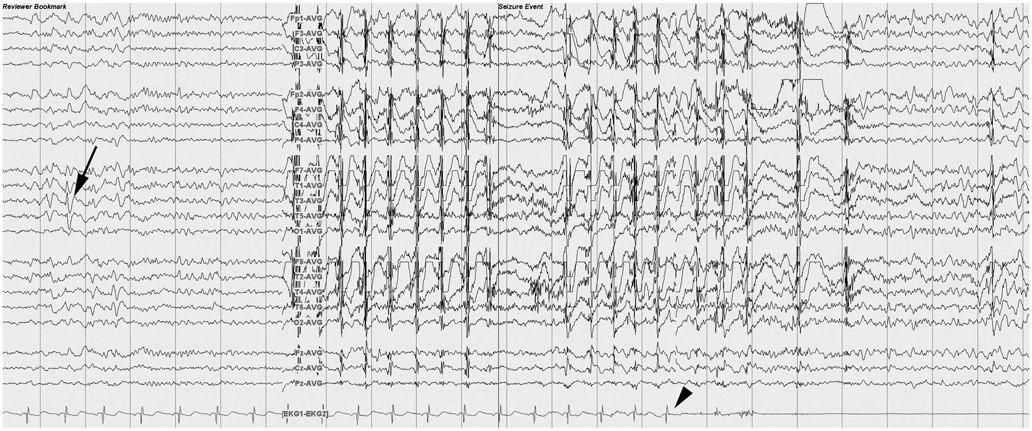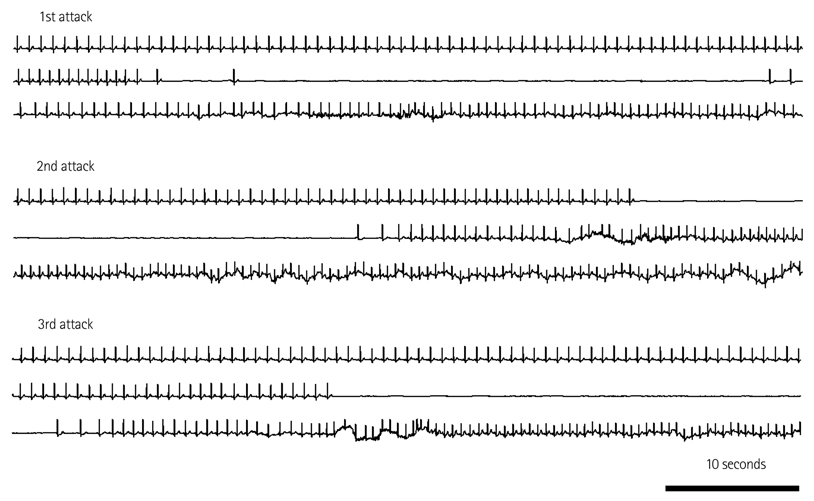Korean Circ J.
2012 May;42(5):349-351. 10.4070/kcj.2012.42.5.349.
Recurrent Syncope Triggered by Temporal Lobe Epilepsy: Ictal Bradycardia Syndrome
- Affiliations
-
- 1Department of Internal Medicine, Seoul National University College of Medicine, Seoul, Korea. seil@snu.ac.kr
- 2Department of Neurology, Seoul National University College of Medicine, Seoul, Korea.
- KMID: 2028765
- DOI: http://doi.org/10.4070/kcj.2012.42.5.349
Abstract
- Ictal asystole is potentially lethal, and known to originate from the involvement of limbic autonomic regions. Appropriate treatment must include an antiepileptic drug and the implantation of a pacemaker. We report the case of a 54-year-old male with recurrent syncope secondary to ictal asystole triggered by temporal lobe epilepsy. This was confirmed by combined Holter and video-electroencephalogram monitoring.
Keyword
MeSH Terms
Figure
Reference
-
1. Brignole M, Alboni P, Benditt DG, et al. Guidelines on management (diagnosis and treatment) of syncope-update 2004: executive summary. Eur Heart J. 2004. 25:2054–2072.2. Reeves AL, Nollet KE, Klass DW, Sharbrough FW, So EL. The ictal bradycardia syndrome. Epilepsia. 1996. 37:983–987.3. Britton JW, Ghearing GR, Benarroch EE, Cascino GD. The ictal bradycardia syndrome: localization and lateralization. Epilepsia. 2006. 47:737–744.4. Blumhardt LD, Smith PE, Owen L. Electrocardiographic accompaniments of temporal lobe epileptic seizures. Lancet. 1986. 1:1051–1056.5. Opherk C, Coromilas J, Hirsch LJ. Heart rate and EKG changes in 102 seizures: analysis of influencing factors. Epilepsy Res. 2002. 52:117–127.6. Frysinger RC, Harper RM. Cardiac and respiratory correlations with unit discharge in human amygdala and hippocampus. Electroencephalogr Clin Neurophysiol. 1989. 72:463–470.7. Freeman R. Cardiovascular manifestations of autonomic epilepsy. Clin Auton Res. 2006. 16:12–17.8. Rugg-Gunn FJ, Simister RJ, Squirrell M, Holdright DR, Duncan JS. Cardiac arrhythmias in focal epilepsy: a prospective long-term study. Lancet. 2004. 364:2212–2219.9. Park KH, Her SH, Lee JM, et al. Brain Tumor is a rare cause of both bradycardia and seizure. Korean Circ J. 2007. 37:449–452.10. Kim JS, Ryu JC, Joo SB, et al. Usefulness of head-up tilt test in adults with syncope or presyncope of unexplained origin. Korean Circ J. 1996. 26:855–864.
- Full Text Links
- Actions
-
Cited
- CITED
-
- Close
- Share
- Similar articles
-
- Three Patients with Nondominant Temporal Lobe Epilepsy Showing Ictal Spitting
- Ictal Vomiting Associated with Temporal Lobe Epilepsy of Dominant Hemisphere
- Ictal Nose Wiping in a Patient with Mesial Temporal Lobe Epilepsy
- Ictal Spitting in a Patient with Dominant Temporal Lobe Epilepsy: Discrepancy between Epileptogenic and Symptomatogenic Areas for Spitting Automatism
- Transient Hyperorality during Automotor Seizure in a Patient with Right Temporal Lobe Epilepsy. Epileptic Kluver-Bucy Syndrome?



